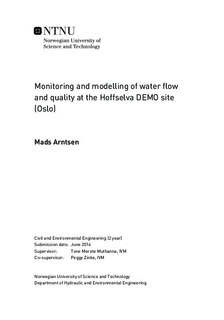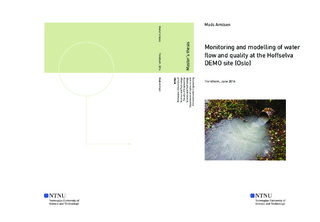| dc.description.abstract | Hoffselva is one of the main rivers in Oslo, flowing from Holmenkollen in the north and down to the fjord by Bestumkilen. Due to low capacity of the pipes in the sewer network, the river is experiencing a rapid frequency of emissions to the river through combined sewer overflows (CSOs). The water quality is poor due to the CSO emissions and other emissions. The municipality of Oslo wants to reach the target of good chemical and ecological state within 2021, set by the national water regulation. The on-going EU-project DESSIN (Demonstrate ecosystem services enabling innovation in the water sector) aims to improve the water quality by using innovative local treatment solutions that enable cost efficient, sustainable mitigation of overloaded sewer systems and thereby increasing the value of eco system services.
The aim of this master thesis is to contribute to the project by setting up, calibrating and applying a 1D hydrodynamic and water quality model for Hoffselva, and to investigate and discuss the potential influence of improved water quality from CSO spills on selected water quality indicators in Hoffselva. To fulfill the objectives, the author has used modeling programs like MIKE URBAN, HEC-RAS and ArcGIS: ArcMap. An existing model in MIKE URBAN has been used to model the activity of combined sewer overflow events during a selected 9-days rain period from the Autumn in 2014. An one-dimensional steady and unsteady simulation model were built in HEC-RAS to simulate the hydrodynamics of the river, and to make a basis for the water quality simulations in the water quality module in HEC-RAS.
The CSO activity modeling for the selected event in MIKE URBAN showed three active CSO (out of 24) in the southern, urban part of the catchment. The results are consistent when compared to the CSO frequency history. Several problems with numerical instability occurred in the unsteady simulations. The unsteady model had to be reduced and simplified to successfully run an unsteady simulation for the lower part of the river. The first unsteady simulation in HEC-RAS gave higher discharge values in the hydrographs than what were observed. After some calibration, the simulated values made a good visual fit with the observed values.
The water quality analysis had to use the hydraulic plan from the steady flow simulation due to an unknown error massage with the unsteady flow data. Different scenarios were made to simulate the water quality under different river conditions for a selected CSO event. The results were consistent with previous reports about poor water quality in the river. The local treatment solution was able to reduce the concentration peaks, but due to the background concentrations in the river, the water quality remained poor for the river Hoffselva in the investigated scenarios. Based on the findings, future work should measure the water quality during different rain events / scenarios, and compare the observed results with the simulated results from the model. Future work on the models should focus on using more detailed measurements as input to the models, as appropriate information about the river discharges is essential. It is suggested to make an unsteady calibrated model for the whole river network in order to have the opportunity to simulate multiple active CSOs at the same time. | |

